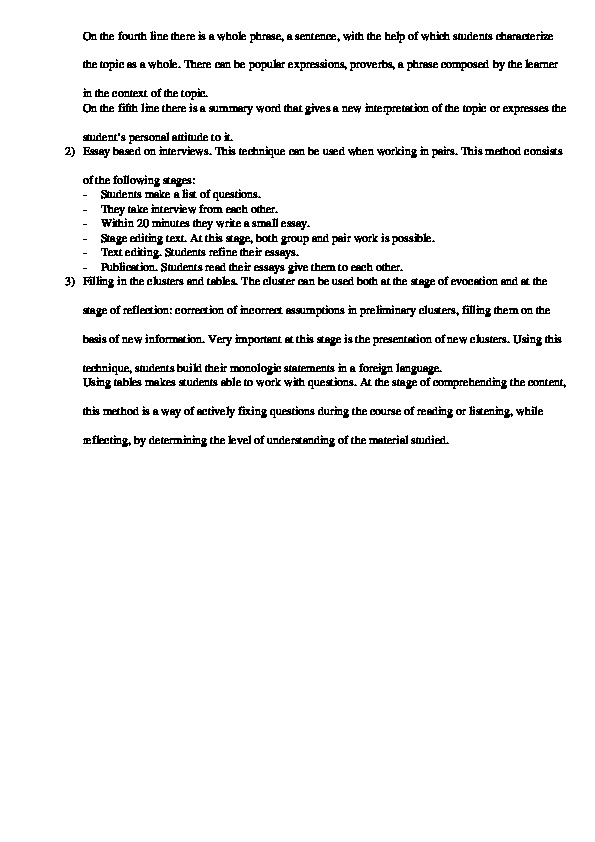This article is written in the English language. It is quite brief and informative. I hope that it will help teachers of English to develop critical thinking skills in different activities for students who learn English as a foreign language.
I have been working as an English teacher for 10 years. I would like to tell you about my method of critical
Methods of critical thinking skills development in primary school.
skills development in the second form (age 79). In Russia it is the first year if studying English. Children are
very curious and creative at this age. There are three main stages of critical thinking skills development.
1) Evocation. This stage allows to actualize and to generalize the material my students already know. It
helps to arouse their interest and to motivate to study.
a) Cluster. It is a way of graphic organization of material. This method is used both during evocation
Methods:
and reflection. It allows to activate words in students’ speech and to exercise different grammatical
structures.
Information is systematized according to clusters (bunches). Key concept is in the center of it. There
b)
are words on the topic around it.
c) Riddle. This method is very effective as for working on lexical skills. It can be used on each stage of
learning English. It helps to develop audial and visual memory. At first, teacher puzzles a riddle,
then students do it.
d) The table of “thin” and “thick” questions. Thin questions are questions that are simple easy to
answer (Yes / no, the 1sy of June and so on). Thick questions are questions that are difficult to
answer (Because I don’t like it and so on).
2) Realization of meaning. This stage allows to get new information, comprehend it, correlate it with
knowledge students already have, analyze new information and their learned information.
Interrogation. It is one of the ways to work in pairs. It helps to improve communication skills.
a)
b) Table “Who?”, “What?”, “When?”, “Where?”, “Why?”. The table id filled in while reading the text.
c) Circles on the water. This method is used to activate students’ knowledge. Reference word is
Methods:
concept or phenomenon that is studied. It is written in the column. Students choose words according
to each letter of the word.
3) Reflection. The main thing here is comprehension, generalization of acquired information. Students
form their own attitude to studied material.
Methods:
1) Cinquain. It is a fiveline poem. It enriches students’ vocabulary/ prepares them for brief retelling
and teaches to formulate the main idea or the key phrase.
On the first line one word is written a noun. It is the topic of cinquain.
On the second line, two adjectives are written, revealing the topic of cinquain.
On the third line three verbs describing the actions that relate to the theme of the cinquain are
recorded.On the fourth line there is a whole phrase, a sentence, with the help of which students characterize
the topic as a whole. There can be popular expressions, proverbs, a phrase composed by the learner
in the context of the topic.
On the fifth line there is a summary word that gives a new interpretation of the topic or expresses the
student’s personal attitude to it.
2) Essay based on interviews. This technique can be used when working in pairs. This method consists
Students make a list of questions.
of the following stages:
They take interview from each other.
Within 20 minutes they write a small essay.
Text editing. Students refine their essays.
Stage editing text. At this stage, both group and pair work is possible.
Publication. Students read their essays give them to each other.
3) Filling in the clusters and tables. The cluster can be used both at the stage of evocation and at the
stage of reflection: correction of incorrect assumptions in preliminary clusters, filling them on the
basis of new information. Very important at this stage is the presentation of new clusters. Using this
technique, students build their monologic statements in a foreign language.
Using tables makes students able to work with questions. At the stage of comprehending the content,
this method is a way of actively fixing questions during the course of reading or listening, while
reflecting, by determining the level of understanding of the material studied.


